
Educational Photography and Content
Education through Photos and Content
Browse Past Items Sold at LaMaster Arms
Even though these items have sold, LaMaster Arms has focused on creating a library of Photos, Videos, and Builder information to help educate the collecting community, public, and next generation of longrifle enthusiasts

Lancaster, pa
Signed Christopher Gumpf Flintlock Rifle
This rifle is attributed to Christopher Gumpf (b. 1761), who was a Master Gunsmith working in Lancaster Boro from 1791 through 1834. He built fine rifles in the classic Lancaster form and made contract rifles for the government in 1794.

Lebanon County, PA
Signed Nicholas Beyer Flintlock Rifle
Nicholas Beyer (b.1780) was a grand master of the late Golden Age of Kentucky Rifles and their construction. Beyer was most likely an apprentice of the famous master, J.P. Beck of Lebanon, PA.
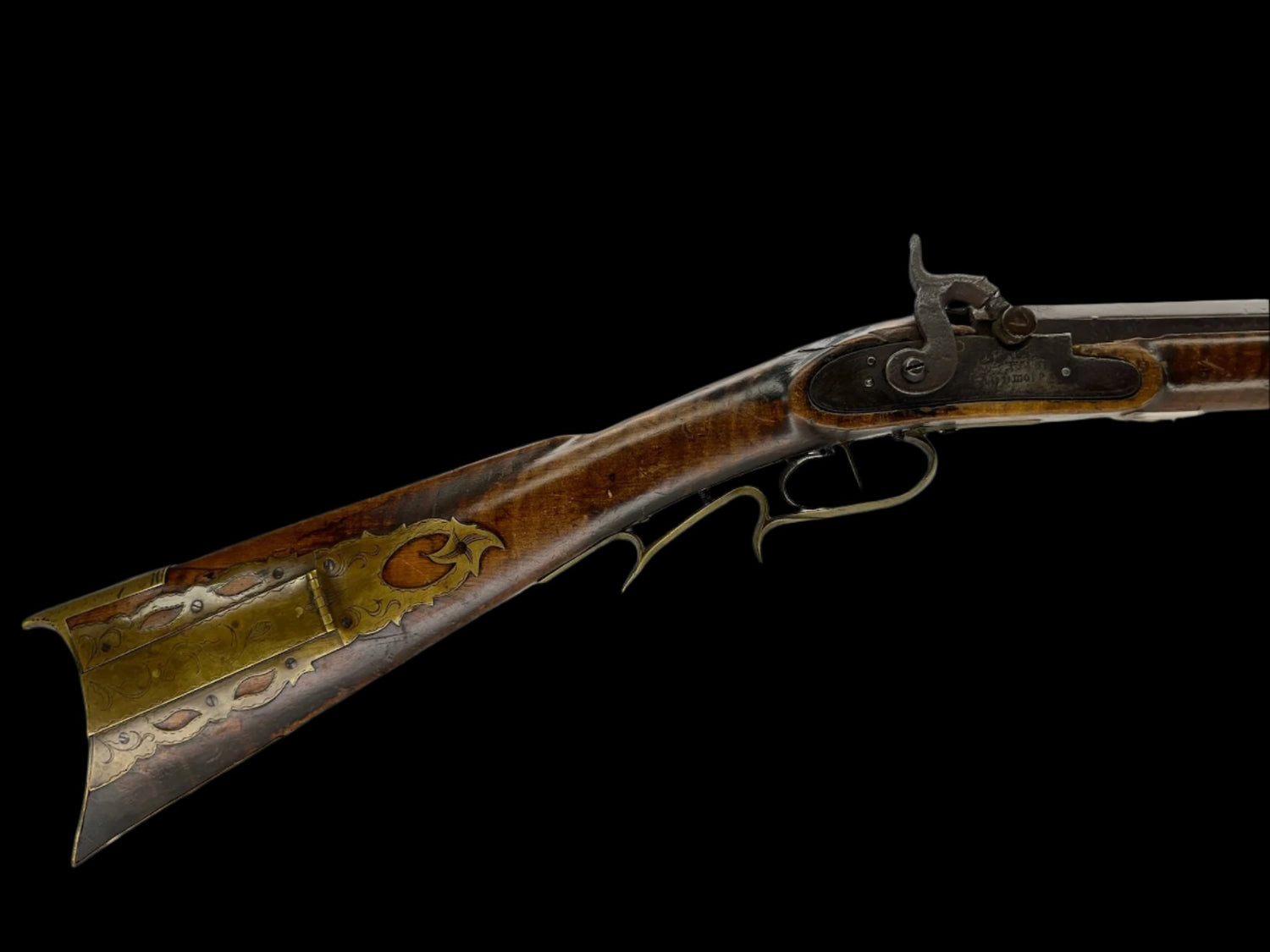
Ohio
Signed John Vincent Rifle
John Vincent (b.1809) is acknowledged as one of the most famous gunsmiths in the Ohio school. According to an article published by William Reynolds, Vincent was originally a cabinetmaker, before learning gunsmithing in his thirties.

York, PA
Signed Adam Ernst Flintlock Rifle
Adam Ernst (d.1857) was a Golden Age gunsmith who worked in Adams and York County, Pennsylvania during his career. Ernst’s rifles and style indicate that he most likely apprenticed with George Eister. Ernst’s work is always precise, delicate, and detail oriented.

York, PA
Attributed George Schroyer Flintlock Rifle
According to Joe Kindig Jr. in his book, Thoughts on Kentucky Rifle in its Golden Age, there were two gunsmiths by the name George Schroyer. A father and son, they were both listed in 1793 tax records as working in Hanover, Pennsylvania. A unique trait with the rifles produced by the Schroyers was the inconsistency of how their last name was spelled in the signature. Various spellings included Sheyer, Scheyer, Shroyer, etc.

North Carolina
Signed Timothy Vogler Percussion Rifle
Signed Rifle Built by Timothy Vogler of the famed Vogler Family of Gunsmiths of North Carolina
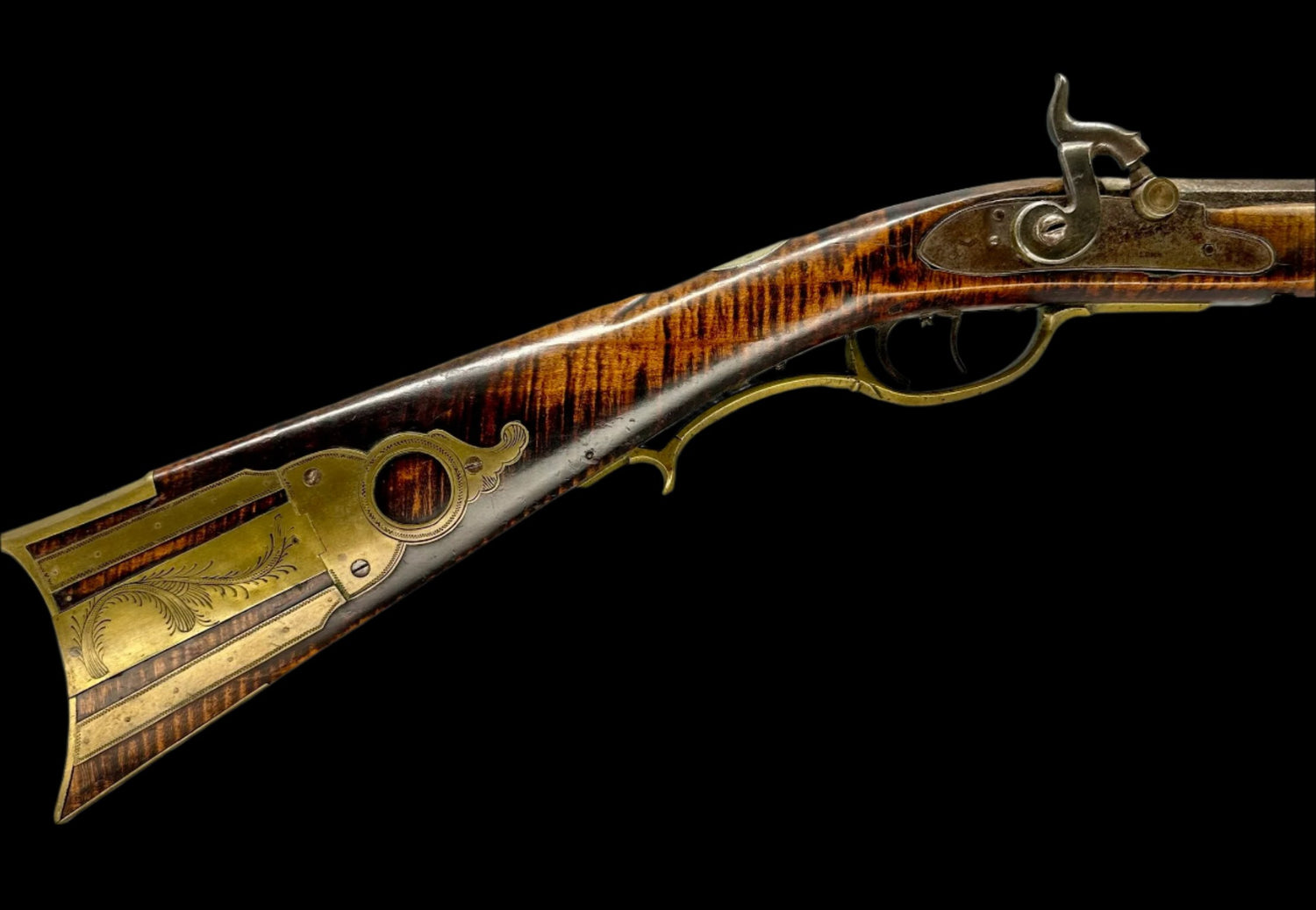
Bedford, PA
Signed Jacob Snider Percussion Rifle
Jacob Snider (1821-1875) worked in Bedford County for his entire gunmaking career. In Snider’s later life, he won a large lawsuit in Colorado, but was promptly gunned down by the plaintiff. Snider’s body was brought back to Bedford, where he is buried today.

LIverpool, OH
Signed Valentine Shuler Percussion Rifle
A fantastic example of a gunsmithing family lineage. Valentine Shuler was a descendant, if not son, of the famed John Shuler of Bucks County, PA.

Littlestown, PA
Attributed Frederick Sell Flintlock Pistol
A Pistol that displays classic American Folk Art, as well as the style of Master Gunsmith, Frederick Sell of Littlestown, PA.

Berks County, PA
Indenture Agreement Signed by Leornard Reedy
Indenture agreement between Leonard Reedy and Mathias Deibler. The document bears the signature of Leonard Reedy, one of the most famous gunsmiths in the Dauphin County school. Reedy apprenticed under John Bonewitz and would later work in Gratz, PA. Reedy’s rifles are stunning examples of the “Golden Age” Kentucky Rifle; as testament to this, one of his rifles is displayed in the Metropolitan Museum of Art.
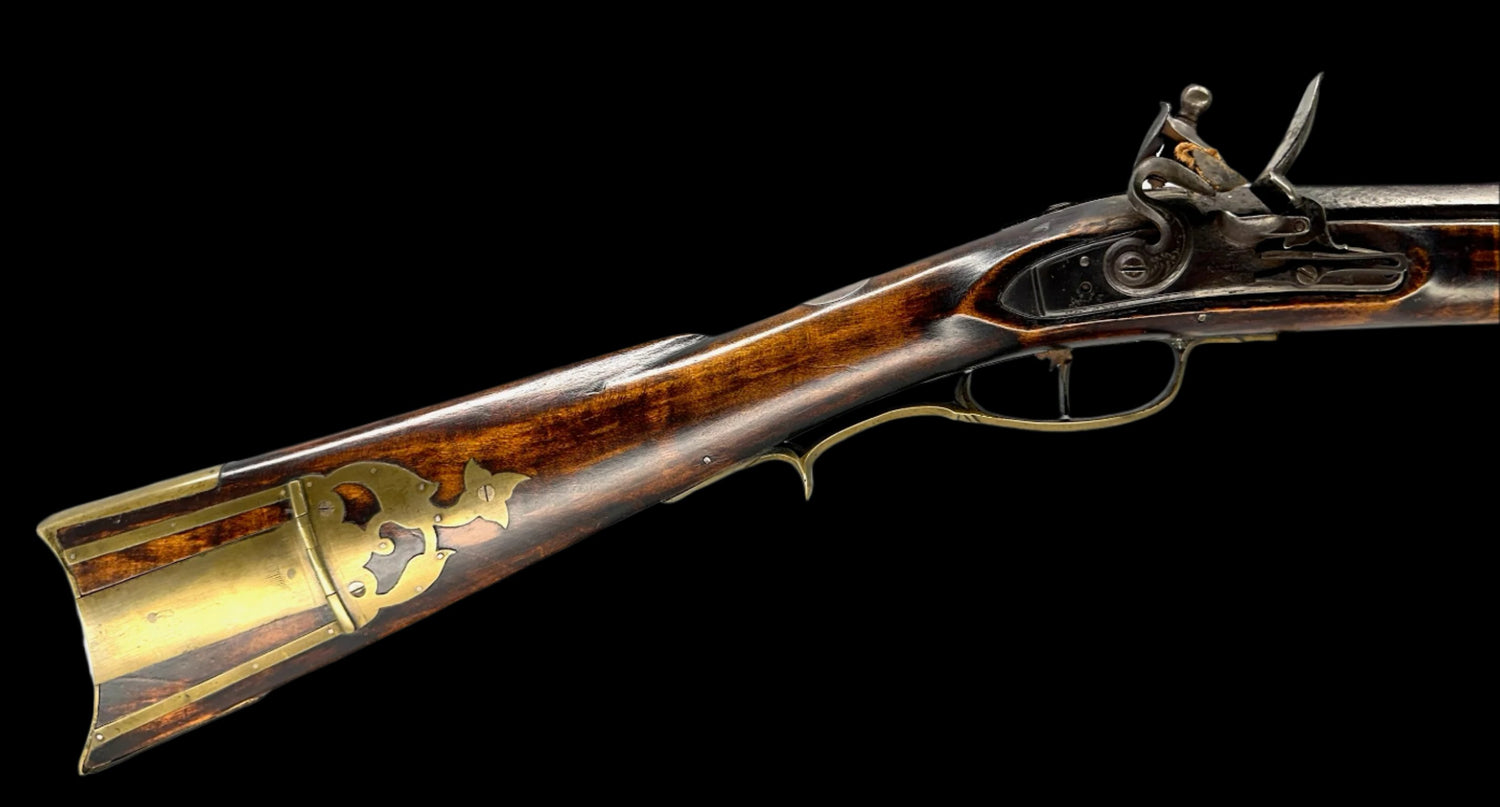
Winchester, Va
Restocked Simon Lauck Flintlock Rifle
Simon Lauck apprenticed in Lancaster in the early 1780’s; after completing his training, Lauck traveled to Winchester, VA and opened his own shop

Cumberland, MD
Signed Hiram Clark Flintlock Rifle
Clark worked out of Cumberland, MD. This Rifle retains its original lock and bears the maker's name on the barrel.

England
Signed S.Wallis "Baker Rifle"
A great example of a Baker rifle that was used by the British Army in the late 18th century. The lock is signed “S.Wallis.” An inscription on the patchbox reads “John Ward, Roxbury 1776—his gun--”.

Bucks county, pa
Attributed Early Bucks County Powderhorn
Horn has been attributed as an early Bucks County Horn. Maple plug. Horn body has been decoratively spotted with iron oxide

CONTEMPORARY PIECE
Contemporary Signed Michael Hayes Flintlock Rifle
A fine contemporary rifle built by Michael Hayes of Park Rapids, MN. Built in the style of a 1780s English sporting rifle.

Philadelphia, pa
Attributed Late Philadelphia Style Powderhorn
Attributed as a late Philadelphia style horn. Plug appears to have had paint or varnish at some point.
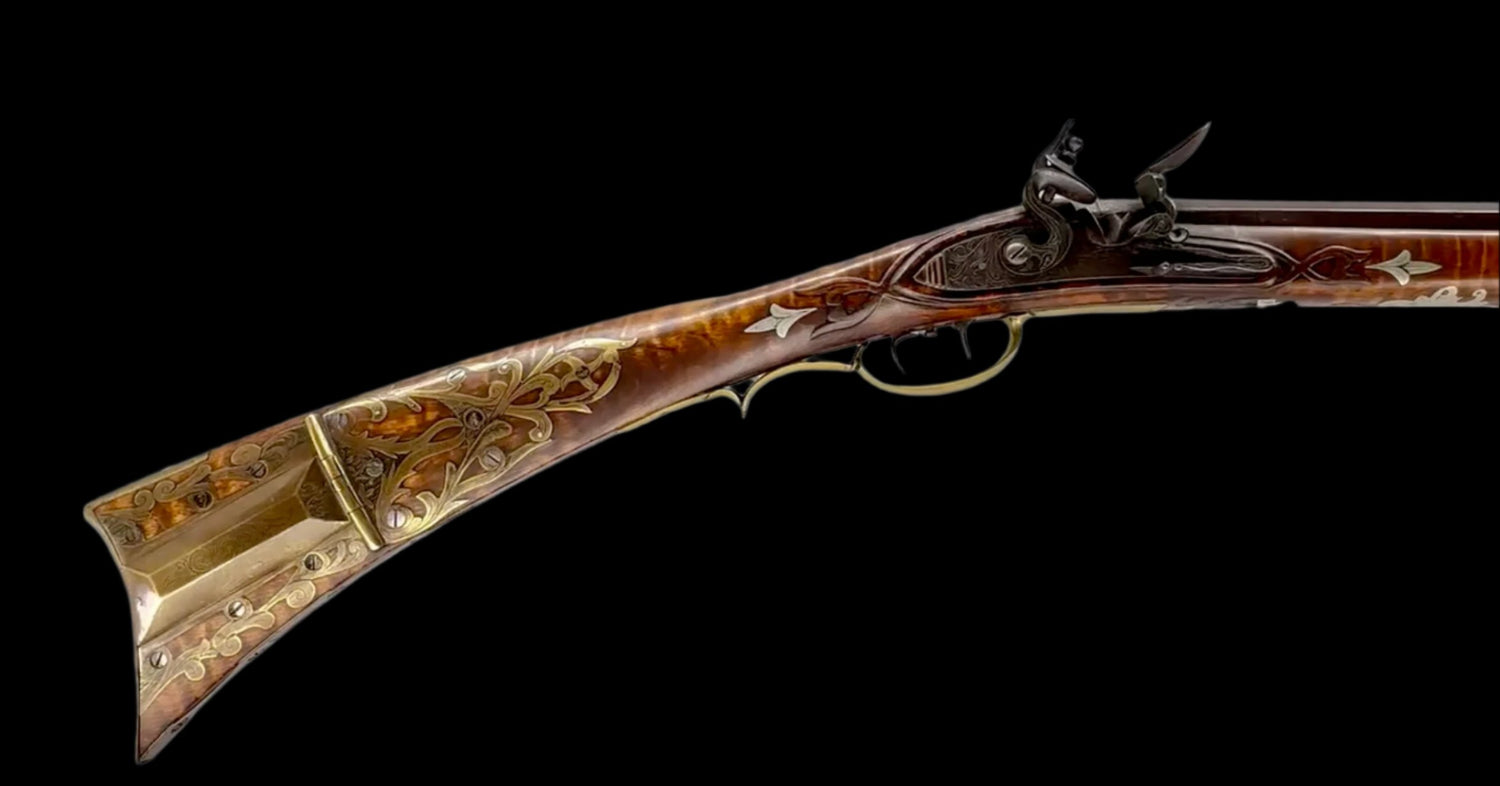
CONTEMPORARY PIECE
Contemporary Signed Wallace Gusler "Audition" Rifle
Mr. Gusler is a Master Gunsmith, who oversaw the gunshop at Colonial Williamsburg’ for many years. This particular rifle is extremely special, as this was Mr. Gusler’s “audition” piece to work at Colonial Williamsburg. Rifle was made in 1960.

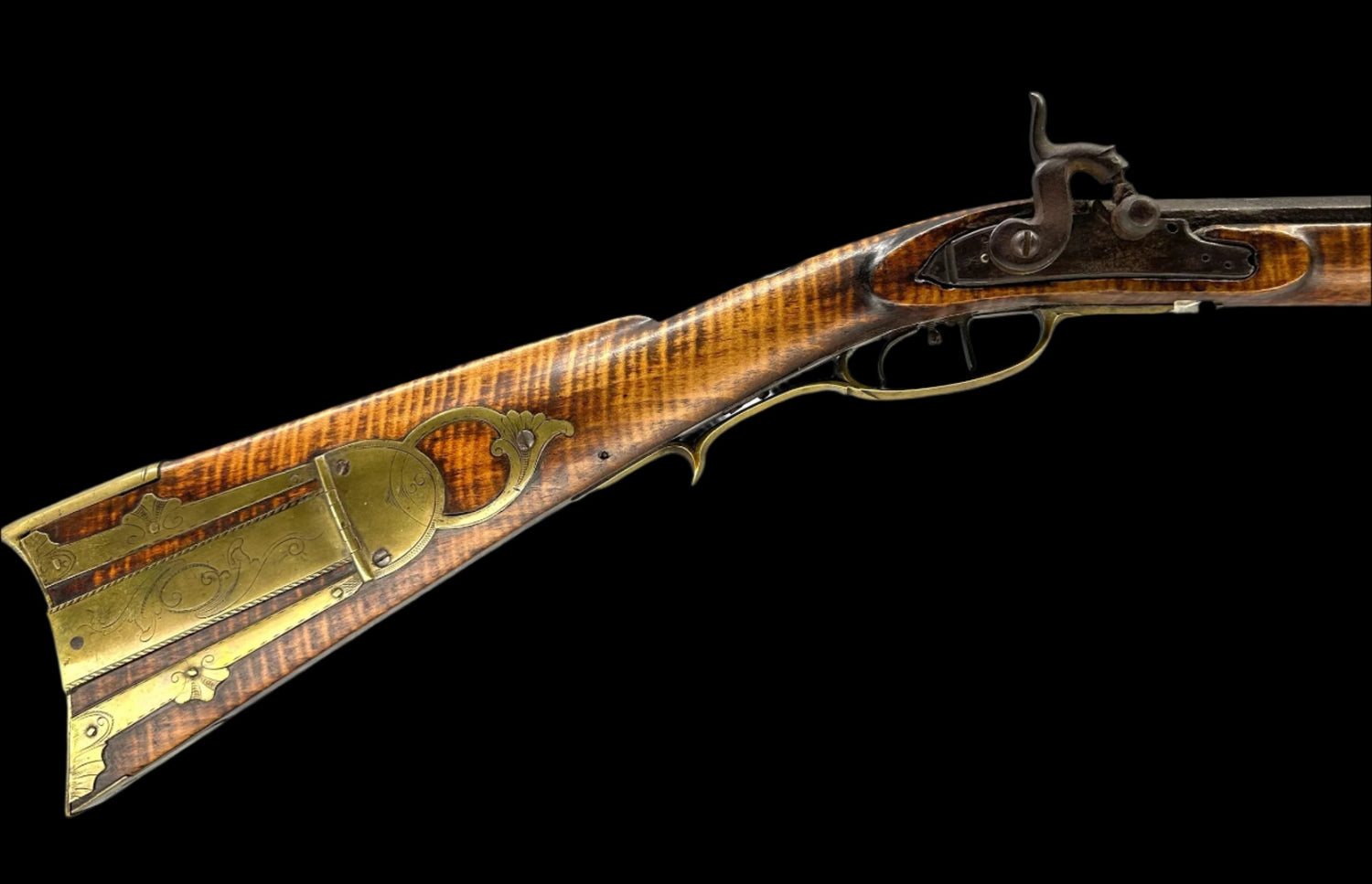
Chambersburg, PA
Unsigned Percussion Rifle
A rifle made in the Chambersburg, PA region. Rifle could have been possibly made by Shillitoe.

France
Signed Andre Crovpison Dragoon Pistol
A dragoon pistol made by Andre Crovpison of France in the 1750s. Decorative silver wire decorates the tang and handle area of the pistol.

England
Signed John Freeman English Fowler
A prestine example of an English Gentleman's Fowling piece.

CONTEMPORARY ITEM
Contemporary R.T.Caster Rifle
Covered in silver wire and built in the styel of Christain's Springs, PA. Masterful attention to detail on this fine piece.

New YOrk or Philadelphia Made
Weston Pistol
Brass barreled pistol that was most likely built in New York City or Philadelphia, PA.

Macungie, PA
Attributed Angstadt Rifle
Built by either Gideon or Joseph Angstadt of the famous Angstadt gunsmithing family. Pennsylvania Dutch folk art decorates this rifle.

RUm, whiskey, or water
Drinking "Canteen" Horn
Soldiers, Frontiersman, and Everyday Folk needed a drink, what better to carry it in than a horn? In-period brass repair patch on the piece.

Lehigh, PA
Attributed Peter Neihart Flintlock Rifle
An attributed Peter Neihart smooth rifle. Covered in wonderful folk art style carving, this piece is wonder to behold.

Berks County, PA
Berks County Horn
Small horn with a fantastic example of Berks County traits, including iron oxide spots and a "beehive" shaped plug
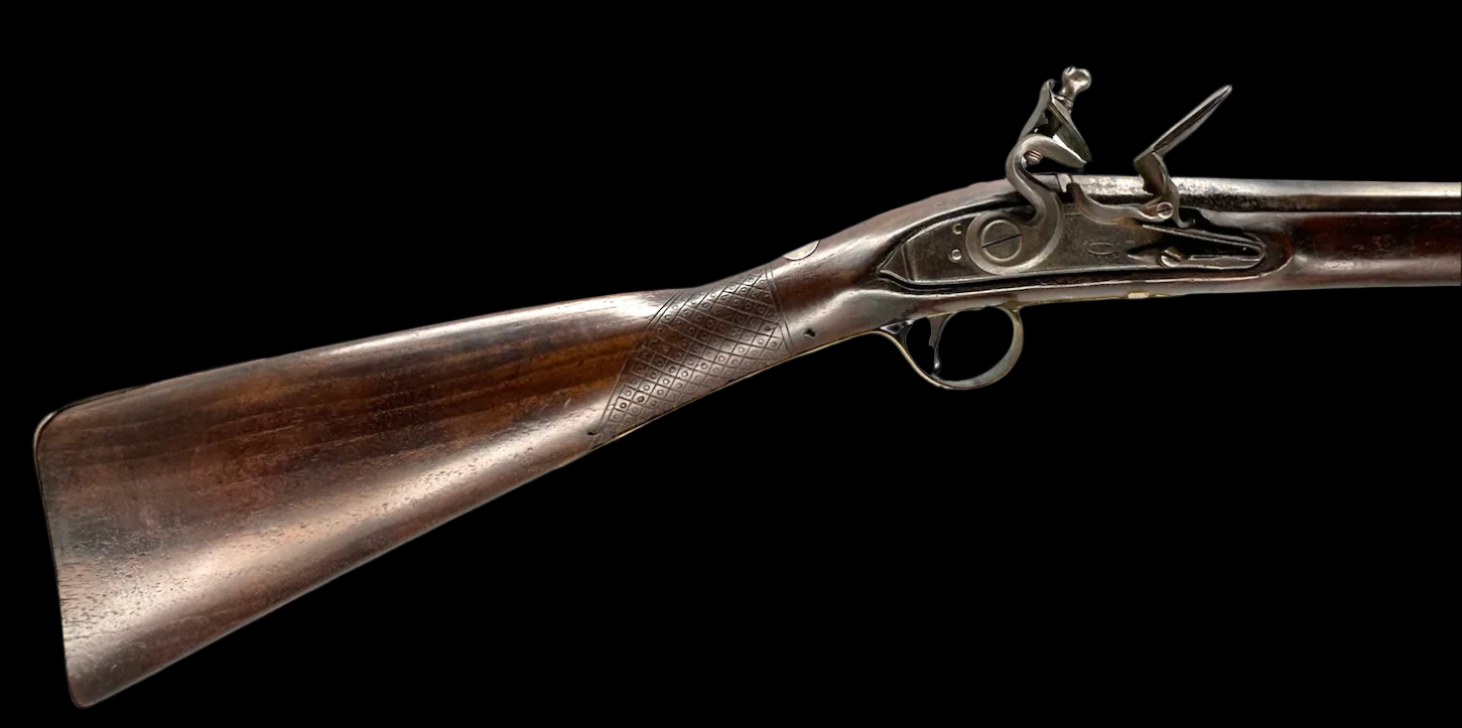
Fredericksburg, VA
Attributed John Bullard Fowler
An Attributed John Bullard Fowler. Bullard's work can be found in Colonial Williamsburg's private collection.

Winchester, VA
Attributed William Lauck Rifle
Attributed to William Lauck of Winchester, VA. Patchbox is a good example of a Lauck gunsmithing family. William Lauck was the last of the Lauck brothers (John, Jacob, and William) to make rifles. The brothers were sons of the famous gunsmith, Simon Lauck.

Curly Ash
Attributed Jacob Lauck Restock Rifle
A fine example of a restocked Lauck rifle, possibly Jacob Lauck. The Lauck family worked in the Winchester, VA area for multiple generations. The fine engraving that decorates the patchbox, cheek piece, and cheek piece vent pick inlay is typical of the style found within Lauck’s work. Another rare aspect of this rifle is the stocking, as it was restocked in Curly Ash; a rare find for even today’s builders. Curly Ash stock has a fine patina on a beautiful surface.

Lancaster, PA
Attributed Christopher Gumpf Contract Rifle
This rifle is attributed to Christopher Gumpf (b. 1761), who was a Master Gunsmith working in Lancaster Boro from 1791 through 1834. He built fine rifles in the classic Lancaster form and made contract rifles for the government in 1794. This rifle retains its original surface. Sweitzer Lock has been converted to percussion. Patch box has decorative inlaid brass wire.

England
Signed "Page" English Pistol
Wonderful example of an English-made pistol from the 1770s time period. From the grotesque mask on the buttcap to the fine details of the sideplate, the furniture is characteristic of the rococo style in its high form.

Beautifully Carved
Contemporary John Bergmann Rifle
Pair text with an image to focus on your chosen product, collection, or blog post. Add details on availability, style, or even provide a review.

Bucks COunty, PA
Attributed John Shuler Flintlock Rifle
While this Attributed John Shuler rifle is not signed, it is a great example of what the school of Bucks County builders could construct. Stocked in curly walnut, which is rare for this region, the rifle is decorated with incised carving on the cheek, wrist (cheek and patchbox sides), lock panels, tang, entry pipe, and moldings.

hampshire County, wv
Signed John Sheets (Sheetz) Percussion Kentucky Rifle
This exquisite antique rifle was crafted by renowned gunsmith John Sheets of Staunton, VA. John Sheets began his journey in the field of gunsmithing as an apprentice under Simon Lauck in Winchester, VA, before establishing his own shop in Staunton in 1796. This particular rifle is a remarkable piece that has descended through the original owner's family near Culpepper, VA.

Allentown School of Rifles
Attributed John Moll Kentucky Pistol
This attributed flintlock pistol is a remarkable piece that showcases fine craftsmanship The intricate design features a prominent lion motif, which is accentuated by an eagle perched on its head. This symbolism is significant, representing strength and nobility, and it may also allude to the fervent anti-English sentiment that characterized the federal period in the United States.

Kentucky Rifle
Unsigned Berks County, PA Flintlock Smooth Rifle
The Smoothbore Flintlock Rifle is a remarkable piece that may be attributed to the George Gunsmithing Family.. This particular rifle features the typical stock architecture associated with Berks County rifles, which not only enhances its visual appeal but also demonstrates the skill of its makers in creating a pleasing overall look.

Somerset, PA rifle
Signed Jacob Mier Percussion Rifle
Rifle built by Jacob Mier of Salisbury, PA (Somerset County). Mier built rifles from the early 1810s through his death in 1873. Rifle has high relief carving on the cheek and unique moldings along the forestock. The patch box is a wonderful example of a “keyhole” style of Western Pennsylvania.

Indian trade gun
French Trade Rifle
This antique French trade rifle is a remarkable specimen, featuring an original flint mechanism and is crafted from European walnut. The furniture of the rifle adheres to the Type C or D Style, with documented references and images available in T.M. Hamilton's "Colonial Frontier Guns" on page 107. The rifle's hardware, intricate carvings, and sideplate reflect the design elements typical of very early French guns, making it a piece of great interest to collectors and historians alike

Shotbag, Horn, and Knife
Contemporary Bag and Kit by Fletcher
Contemporary set made by Fletcher. Horn, Knife, and Bag .
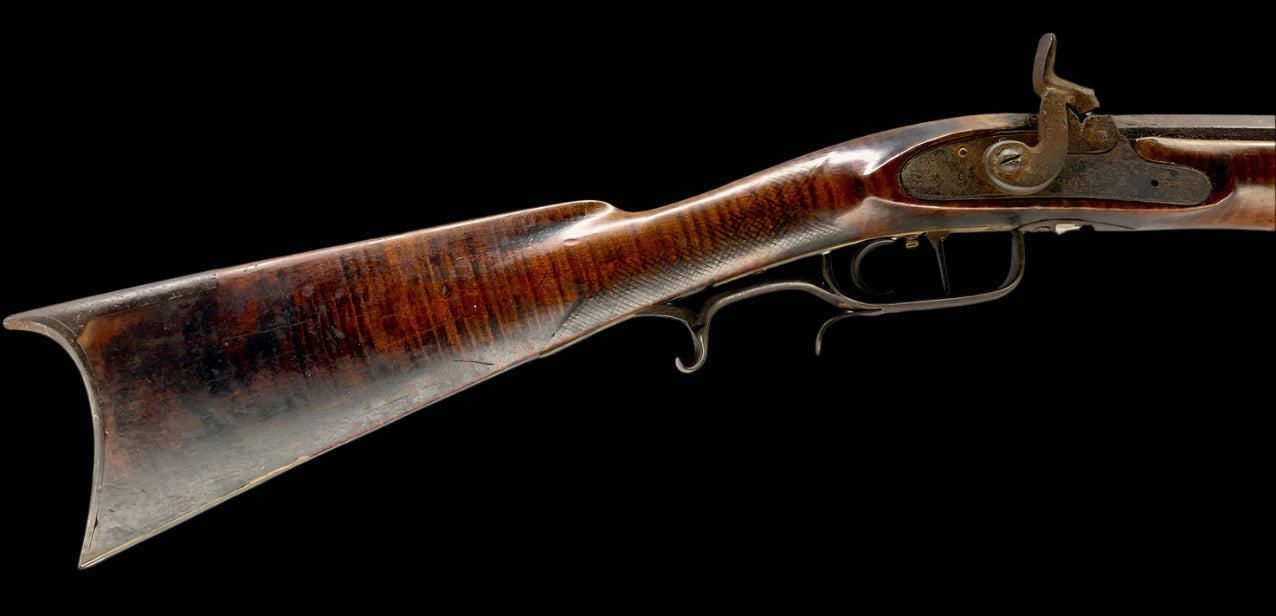
West virginia
Signed Andrew McDermit Percussion Kentucky Rifle
Very distinctive, well-built rifle by Andrew McDermit of Point Pleasant, WV. McDermit was a Civil War veteran who is documented as fighting in the Battle of Gettysburg in 1863. The hand forged triggerguard is elaborate and should be appreciated for its craftsmanship.

York, PA School of Gunsmithing
Signed Adam Ernst Kentucky Rifle
Pair text with an image to focus on your chosen product, collection, or blog post. Add details on availability, style, or even provide a review.

Keep Your Powder Dry!
Folk Art Powderhorn
This antique powder horn is a beautifully crafted piece, showcasing intricate scrimshaw designs of nature and wildlife. The horn features a detailed natural scene, highlighting fish, trees with birds gracefully perched among the branches, and a possible eagle.Another captivating element of the horn is the scrimshawed image of a running deer with a dog in pursuit.

Dublin Ireland
Irish Rigby Flintlock Carbine
This Irish Rigby Carbine, crafted by Trulock around 1830, offers a unique piece of history for collectors and reenactment enthusiasts. Notably, this firearm has not undergone any restoration, preserving its authentic craftsmanship and character over the years. The carbine features its original flintlock mechanism.

british Coat of Arms
Early American Cow Horn Patchbox Lid Cover Dated 1766
This exceptionally rare antique patchbox lid cover dates back to 1766 and is crafted from cow horn, showcasing the intricate English coat of arms. The piece features a captivating folk art scrimshaw design, depicting a man on horseback wielding a sword, alongside an owl, which adds a unique touch of character.

Attributed Kentucky made Rifle
Signed Henry Powell "Over the Log" Percussion Rifle
A great example of an “over the log” rifle. Weighing in at 12 lbs 10oz, this rifle is signed in block letters“Henry Powell.” The rifle is believed to have been possibly made in Kentucky and stocked in Walnut.

Powder Horn
Berks County, PA Powder Horn
This antique powder horn from Berks County, Pennsylvania is a well-preserved example of 18th-century craftsmanship. The horn features a nice beehive-shaped plug and retains its original collar, tip, and buttcap.

Kentucky Rifle
Signed Amos R Fisher Percussion Rifle
This rifle, built circa 1840 by Amos R. Fisher of Winchester, Virginia, is a fine and fairly rare example from a little-known yet skilled regional gunsmith. The rifle is signed “ARF” on a silver signature plate inlaid into the barrel, and notably, the lock is also marked “ARF,” indicating that Fisher not only built the rifle but also crafted the lock.
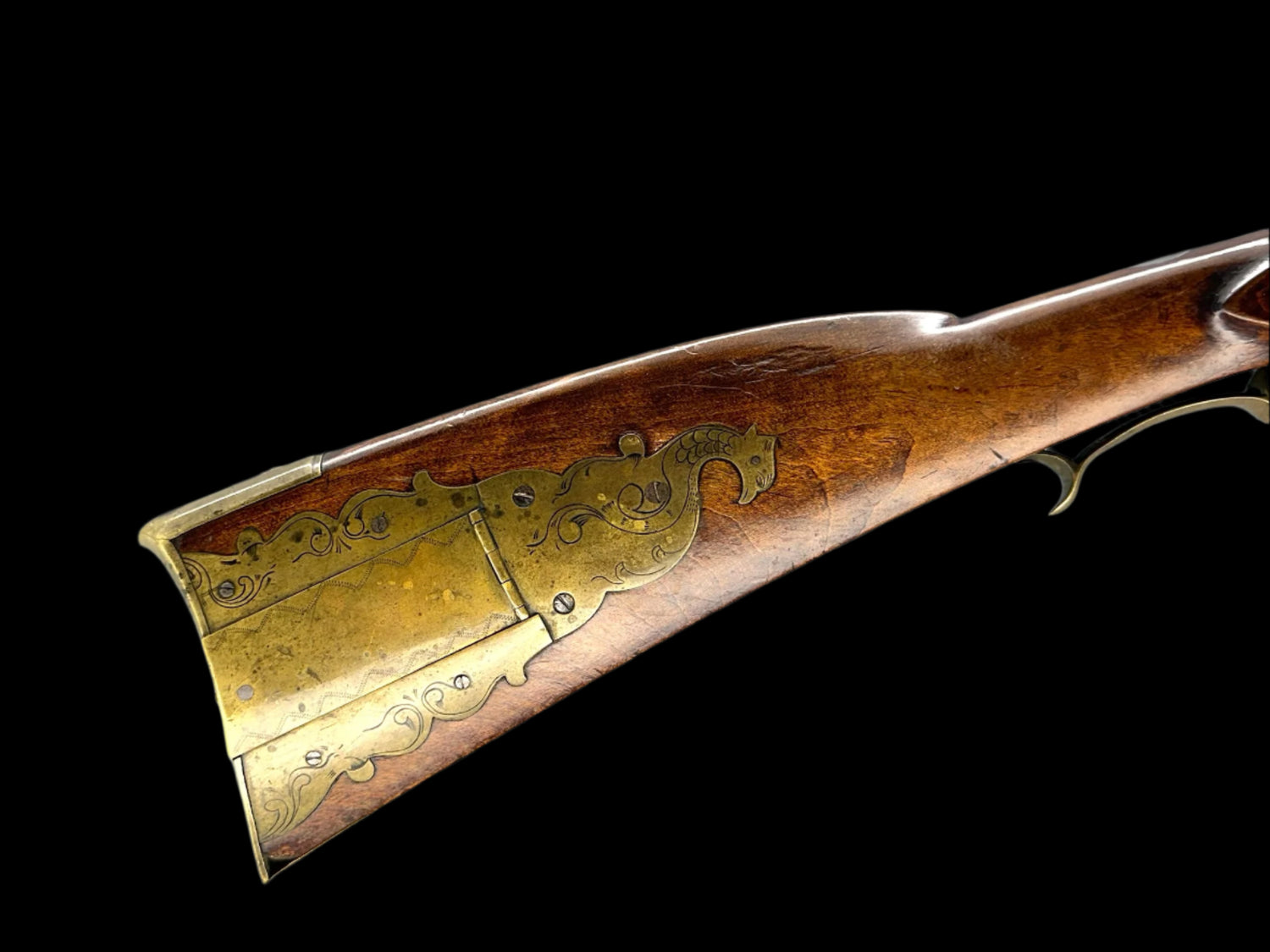
Kutztown, PA
Attriburted Angstadt Kentucky Rifle
This antique Kentucky rifle, attributed to the Angstadt family of gunsmiths, is a fine and evocative example of southeastern Pennsylvania rifle-making tradition. Retaining its original flintlock configuration, the lock is marked “J. Golcher,” a well-known 19th-century lock maker whose components were widely used by contemporary craftsmen.

Philadelphia School of hornmaking
Late Philadelphia Screw-Tip Powderhorn
Pair text with an image to focus on your chosen product, collection, or blog post. Add details on availability, style, or even provide a review.

Large, Folk art horn
Dated 1885 Folk Art Powderhorn
Pair text with an image to focus on your chosen product, collection, or blog post. Add details on availability, style, or even provide a review.

Winchester, VA Rifle
Contemporary Don Viens Half Stock Percussion Rifle
Built by Don Viens, a skilled craftsman who was based in Winchester, VA, this contemporary rifle is a remarkable blend of artistry and functionality. This rifle can be classified as either a ladies or boys rifle, tailored to meet the aesthetic and practical needs of younger or smaller shooters.

Centre County, PA School of gunmaking
Signed David Albright Kentucky Rifle
David Albright was the son of Jacob Albright Sr, the well-known Centre County gunsmith. David Albright’s work is rare, and this may be the only known rifle made by him. The rifle is decorated with incised carving on the cheek and wrist. The cheek carving has the initials “DA” in the same style of Jacob Sr’s work.

“The rifle Brian LaMaster crafted for me is nothing short of a work of art. The fine details, quality materials, how he uniquely customized it to me and my family, and the precision and beauty of each element are beyond anything I could have hoped. Brian’s polite, easygoing demeanor made him a pleasure to work with, and after our initial consultation, he checked in as it progressed. Whenever he sought my input on specific details, I’d answer, ‘I’d never tell Michelangelo what paint or brush to use on the Sistine Chapel ceiling.’ I’ve been blessed to hold, own, and shoot a fair number of firearms over the years, and this is a rare and special gun. It became an instant family heirloom my sons are all vying for, and they’re already planning a shoot-off for who eventually gets it.” —G.C.
